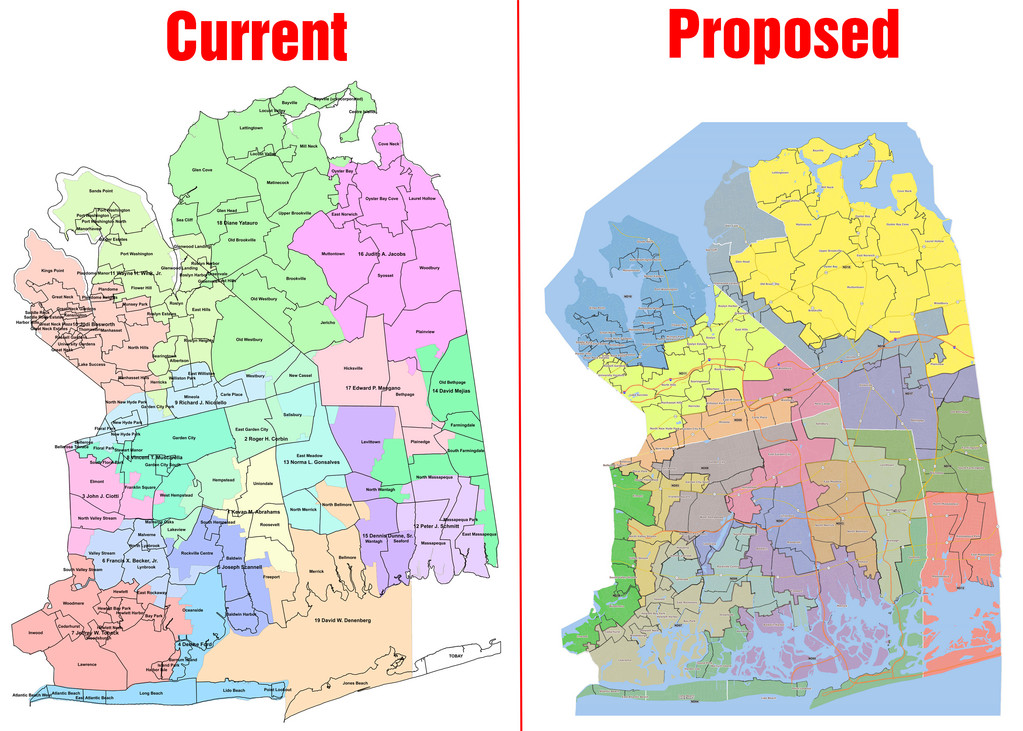Five Towns divided by GOP plan
Democrats say they will fight redistricting plan in court
Though reaction to the redistricting plan put forward by the Republican majority in the County Legislature has been greeted with mostly partisan reactions, local feedback focuses on the part of the proposal that would split the Five Towns into two different legislative districts.
The GOP plan would virtually cut the Five Towns in half. Currently, all of the local communities are in District 7. The new plan would separate Inwood, Woodmere and approximately half of Cedarhurst and create a new 19th District, or what the Legislature’s presiding officer, Peter Schmitt (R-Massapequa), called a “third minority district.”
About half of Cedarhurst, Lawrence, Hewlett and the smaller communities of Hewlett Bay, Hewlett Harbor, Hewlett Neck and Woodsburgh would remain in District 7. The current configuration of the 19th District includes the Merrick-Bellmore area.
The county charter mandates that the Legislature’s lines be redrawn every 10 years to ensure that the population in each of its 19 districts remains roughly equal, at 70,000, and that minority residents are fairly represented. A May 9 public hearing is scheduled, and the plan is expected to be presented to the Legislature for approval on May 16.
“We are not pleased to divide up our
village,” said Cedarhurst Trustee Ari Brown, who added that he is reviewing the
proposal.
But the Legislature’s Republicans view their plan as a fair one that reflects the current population distribution and creates another minority district. The Democrats oppose the plan because it moves 59 communities — and 44 percent of the county’s population — into different districts.
District 7 Legislator Howard Kopel (R-Lawrence) said he has mixed feelings about the plan because he has invested a great deal of time, energy and emotion in getting to know his constituents. “I am lobbying for some changes. However, this kind of thing is tricky,” said Kopel, noting that if 10,000 residents are moved from one district, 10,000 others have to be moved to maintain the legally required population in each district.
Though he said that the planned division of Cedarhurst is a terrible idea, Kopel added that he thinks the Five Towns could gain influence, since it would now have two legislators “working towards the needs of the community,” he said.
Other parts of the plan include merging the two districts held by Democratic Legislators Joseph Scannell (5th District) and David Denenberg (the current 19th District) and extending District 4 east to Jones Beach and north to Seaford. This would lump Seaford and Long Beach together in one district.
Legislative lines were last redrawn in 2003 by a Democratically controlled Legislature. The Republican minority challenged the redrawn lines in court, saying that the new districts were oddly shaped and divided communities in order to provide Democrats with a political advantage in future elections.
Now Democrats are crying foul, saying that redistricting must be undertaken by a bipartisan commission and fully vetted through a series of public hearings, a process they say they followed in 2003. Claiming that the Republicans’ redistricting plan is politically motivated, they are promising a court fight if the majority moves ahead with redistricting on its own.
“To me the Republicans have no right to redistrict now,” said Steve Anchin of the Five Towns Democratic Club, noting that it is only five months until the legislative election. “This is a textbook example of gerrymandering.”
Anchin said that the Five Towns need only one representative, and compared the Republicans’ plan to the Town of Hempstead’s separating the Hewletts from the Five Towns when it created its districts.
“They should draw as straight lines as possible and keep it to a grid,” Anchin said, “and let the people vote, let them decide the issues.”
Republicans took control of the Legislature in 2009. Schmitt has said that the lines must be redrawn within six months of the release of the U.S. census, according to the county charter. He said he expects the redrawn legislative map to be adopted within weeks after the May 9 public hearing.
The County Legislature was formed on May 24, 1994, after U.S. District Court Judge Arthur Spatt had ruled in 1993 that the county’s longstanding Board of Supervisors was unconstitutional because it violated the Constitution’s one-person, one-vote rule. A 19-district Legislature was created to replace the Board of Supervisors. The Legislature’s first election took place in November 1995, and the legislators took office for the first time on Jan. 1, 1996.

 62.0°,
Overcast
62.0°,
Overcast 




